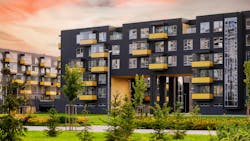The Smart Money: Modernizing Multifamily
Key Highlights
-
Access control as a top proptech investment: Modern solutions improve safety, convenience, and operational efficiency, making them highly valued by both residents and property managers.
-
Retrofit challenges and choices: Owners must weigh network needs (Wi-Fi vs. offline), infrastructure upgrades, and vendor fragmentation when modernizing older multifamily properties.
-
Market driver: With rising competition in multifamily housing, retrofitted access control is becoming a key differentiator and a prerequisite for broader smart building initiatives through at least 2027.
This article originally appeared in the August 2025 issue of Security Business magazine. Feel free to share, and please don’t forget to mention Security Business magazine on LinkedIn.
For many owners and operators looking at making proptech and smart building investments, access control is the first area they examine – and for good reason, as modern access control solutions are a win/win/win for residents, on-site staff, and owners/operators.
Proptech solutions enhance safety and convenience, while also improving worker efficiencies and supporting new use-cases.
The access control solutions may be composed of one or multiple parts – a gate and intercom system in the case of gated communities, an intercom or buzzer on a base building, access-restricted elevators, restricted amenity rooms, and smart door locks on residential units. Oftentimes, access control solutions are integrated with other solutions such as self-guided touring solutions, maintenance management platforms, and delivery services such as Amazon Key, or even smart concierge platforms.
Access control is a desired resident amenity. Safety and security are of great interest to residents and prospective residents, with multifamily residents in a recent Parks Associates study rating the importance of security systems in their next home and community at the same level of importance as they rated a fitness center or gigabit internet speeds.
Next-gen solutions that support mobile credentialing allow smartphones – or even smartwatches – to serve as a key to residential units or to the property, providing great convenience to residents. Guest access and guest management solutions also make it easier for residents to admit their visitors onto the property, compared to having to traditional callboxes or having to collect visitors in person.
Access Control Retrofits: What to Consider
The multifamily housing stock is decades old, and many units are located in properties that were not originally designed for broadband internet or cable TV, much less Internet of Things or smart building solutions. This means that infrastructure is a key concern for those retrofitting with new solutions.
Cloud and Wi-Fi vs. Local Networking: Smart building solutions, including access control, require some type of network to operate. Many key decision makers have identified Wi-Fi as their network of choice for enabling IoT deployments – Wi-Fi is a common standard, widely supported by IoT devices, with no vendor lock-in, that supports a wide number of potential devices and use-cases. However, adding in Wi-Fi networks throughout the property also commonly means retrofitting in internet cabling – either fiber or Ethernet cables, nowadays commonly CAT 6 or higher – which can be an expensive and time-consuming proposition, depending on the type of building and how it was constructed. It is also disruptive to residents and takes both time and resources to manage.
Offline solutions avoid these expenses and headaches but require a regular schedule of battery checks and replacements, as well as firmware updates. Residents need to be manually removed from locks during the turnover process.
For properties looking at new proptech and smart building deployments, these are the tradeoffs that must be considered.
Avoiding Fragmentation: Multifamily owners and operators, as well as onsite staff, are increasingly overwhelmed by the sheer volume of proptech solutions they have. An MDU company has 21 different vendors on average, each of which will commonly have their own separate login information and may require a separate onboarding/offboarding and credentialing process for residents.
This excess of vendors can oftentimes lead to an overabundance of apps that create confusion among residents and on-site staff, which then results in fewer people using the solutions than would otherwise be the case. Fragmentation may also prevent operations teams from being able to access valuable data and insights that can help guide decision-making.
Properties must select solutions that avoid these fragmentation headaches – either those that are vertically integrated, and/or those that seamlessly integrate with other components of access control solutions.
Integration with the property management system is a must-have, but owners and operators should also look for single sign-on and a user experience that is – if not unified – then at least similar regardless of whether staff or a resident is using it. This makes it easier for staff to understand the resident experience and explain it to residents when they have questions.
Staying Ahead in a Changing Market
The market for multifamily housing is changing. With historic amounts of new inventory coming online, competition for renters is set to grow – setting the stage for sluggish rent increases and risking lower returns. To counteract this, key decision makers are examining proptech as a way to enhance property values by increasing efficiencies, lowering expenses, and providing a valued amenity that residents and prospective residents are willing to pay a little extra for.
Access control is, for many looking to retrofit, a top area of investigation and investment. Access control has a well-understood value proposition for both decision makers and residents, many companies already have similar mechanical systems in place and would benefit from upgrading, and next-gen access control solutions are necessary prerequisites for larger initiatives such as self-guided tours and centralized leasing.
Parks Associates expects that retrofitting will be a major trend all the way until 2027 – and will continue to be highly impactful for many companies even after new construction activity picks up speed. Companies with existing properties will increasingly need to compete not just with new construction, but also with neighbors that have taken the opportunity to retrofit solutions into their own properties.
This is an excerpt from a whitepaper, Modernizing Multifamily Spaces: Retrofitting Access Control. The whitepaper, written in partnership with Kwikset, examines how new access control solutions are being used to lower total cost of ownership compared with mechanical systems and how companies are deploying these technologies into even unconnected properties. Learn more at www.parksassociates.com.
About the Author

Kristen Hanich
Kristen Hanich is Director of Research for Parks Associates. https://www.parksassociates.com
